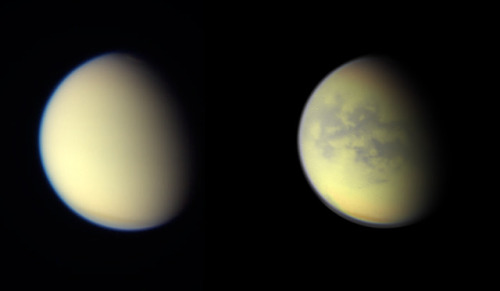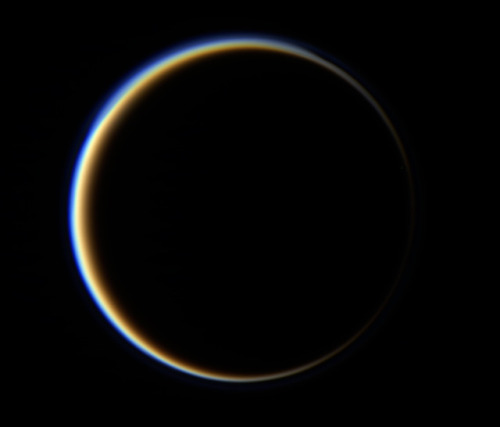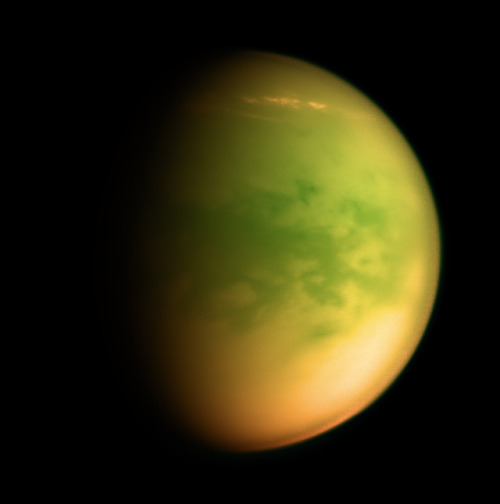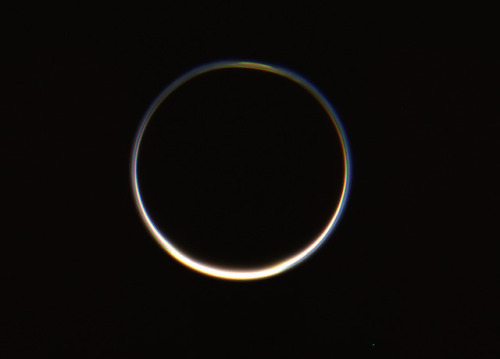Triangulum Log - Post 5 - Vista System (Planet 3)









Triangulum Log - Post 5 - Vista System (Planet 3)
Our journey of the Vista System now takes us to the third and largest planet in the system. This gas giant has 1.14 times the mass of Jupiter and a mean radius of 73,934 kilometers. It is much warmer than Jupiter at -41° F versus Jupiter’s -163° F, and as a result has extremely active weather patterns and a stormy atmosphere. Cloud decks are composed primarily of water-ice crystals.
The planet orbits 0.88 astronomical units from the sun, has an extensive ring system composed of silicate-rich materials, and a single large satellite. The planet’s satellite has a radius of 1,360.71 kilometers and a mass roughly 70% that of our moon. It has an average density of 4.82 g/cm³, indicating a large metal-rich core region.
Links to High Resolution Pics
Image 1 - A Giant and her rings.
Image 2 - Beautiful faint ring system.
Image 3 - Stormy Skies
Image 4 - Ring Shepard.
Image 5 - Andromeda Photobombs the rings. (High Exposure Shot)
Image 6 -Battered moon.
Image 7 - David and Goliath
Image 8 - High and Seek
Image 9 - Parting Ways
More Posts from Sharkspaceengine and Others





Vernier System - Post 2 (Third Planet and its moons)
Here we come across the system’s third planet, a Jupiter-Sized gas giant 1.18 Jupiter Masses orbiting the two suns at an average distance of 2.33 AU. Four massive moon’s all with atmospheres orbit’s the giant. The planet has a very faint ring system in orbit.
High Resolution Pic of the 3rd Planet
Note, the large red nebula in the background NGC 604, one of the largest know nebulas. The Vernier System is located 4,600 light years from the nebula. From here NGC 604 covers over 16 arc degrees of the sky (36 Full-moons), and shines with an average magnitude of -1.91.
The first moon is barren with a surface covered in craters and gray-colored regolith. It is 3.4 lunar masses, with a radius of 2,603.31 km. A thin sulfur dioxide atmosphere clings to the surface. The atmosphere has a very low surface pressure of 0.0001 atmosphere’s. The moon still appears to be volcanically active.
High Resolution Pic of the 1st moon
The second moon has 4 lunar masses with a radius of 2,956.36 kilometers. It’s surface is more geologically diverse with larger quantities of iron oxide. It is more Mars-like than Lunar-like. A sulfur dioxide atmosphere also covers the surface, but is thicker with a surface pressure of 0.017 atmospheres, or roughly just under 3 times thicker than the atmosphere of Mars.
High Resolution Pic of the 2nd moon
The third satellite is by far the largest, and is an Earth-sized moon with a mass of 0.56 Earth’s and a radius 93% that of Earth. It has a thick carbon dioxide-ammonia atmosphere, with a surface pressure 3.48 times that of Earth. Weather is very active on the surface, and the temperature averaging 230 K (-45 °F) supports liquid sulfur dioxide. Sulfur dioxide rain is also common on the surface. The satellite also appears to have a magnetic field.
High Resolution Pic of the 3rd moon
The fourth moon is a second largest with a mass of 0.07 times that of Earth and a radius of 3,274.23 kilometers. It also has a thin sulfur dioxide atmosphere, and sulfur dioxide ice-caps. The atmosphere is 0.017 atmosphere’s thick.
High Resolution Pic of the 4th moon
The System Tag for this system in Spaceengine is RS 1229-169-6-235375-219.
Why Won’t Our Parker Solar Probe Melt?
This summer, our Parker Solar Probe will launch to travel closer to the Sun than any mission before it, right into the Sun’s outer atmosphere, the corona.

The environment in the corona is unimaginably hot: The spacecraft will travel through material with temperatures greater than 3 million degrees Fahrenheit.
So…why won’t it melt?
The Difference Between Heat and Temperature
Parker Solar Probe was designed from the ground up to keep its instruments safe and cool, but the nature of the corona itself also helps. The key lies in the difference between heat and temperature.
Temperature measures how fast particles are moving, while heat is the total amount of energy that they transfer. The corona is an incredibly thin and tenuous part of the Sun, and there are very few particles there to transfer energy – so while the particles are moving fast (high temperature), they don’t actually transfer much energy to the spacecraft (low heat).

It’s like the difference between putting your hand in a hot oven versus putting it in a pot of boiling water (don’t try this at home!). In the air of the oven, your hand doesn’t get nearly as hot as it would in the much denser water of the boiling pot.
So even though Parker Solar Probe travels through a region with temperatures of several million degrees, the surface of its heat shield will reach only about 2,500 F.

The Heat Shield
Of course, thousands of degrees Fahrenheit is still way too hot for scientific instruments. (For comparison, lava from volcano eruptions can be anywhere between 1,300 to 2,200 F.)
To withstand that heat, Parker Solar Probe is outfitted with a cutting-edge heat shield, called the Thermal Protection System. This heat shield is made of a carbon composite foam sandwiched between two carbon plates. The Sun-facing side is covered with a specially-developed white ceramic coating, applied as a plasma spray, to reflect as much heat as possible.

The heat shield is so good at its job that even though the Sun-facing side of the shield will be at 2,500 F, the instruments in its shadow will remain at a balmy 85 F.
Parker Solar Probe Keeps its Cool
Several other designs on the spacecraft help Parker Solar Probe beat the heat.
Parker Solar Probe is not only studying the Sun – it’s also powered by it. But even though most of the surface area of its solar arrays can be retracted behind the heat shield, even that small exposed segment would quickly make them overheat while at the Sun.

To keep things cool, Parker Solar Probe circulates a single gallon of water through its solar arrays. The water absorbs heat as it passes behind the arrays, then radiates that heat out into space as it flows into the spacecraft’s radiator.
It’s also important for Parker Solar Probe to be able to think on its feet, since it takes about eight minutes for information to travel between Earth and the Sun. If we had to control the spacecraft from Earth, by the time we knew something went wrong, it would be too late to fix it.
So Parker Solar Probe is smart: Along the edges of the heat shield’s shadow are seven sensors. If any of these sensors detect sunlight, they alert the central computer and the spacecraft can correct its position to keep the sensors – and the rest of the instruments – safely protected behind the heat shield.

Over the course of its seven-year mission, Parker Solar Probe will make 24 orbits of our star. On each close approach to the Sun, it will sample the solar wind, study the Sun’s corona, and provide unprecedentedly close up observations from around our star – and armed with its slew of innovative technologies, we know it will keep its cool the whole time.
Parker Solar Probe launches summer 2018 on its mission to study the Sun. Keep up with the latest on the mission at nasa.gov/solarprobe or follow us on Twitter and Facebook.
Make sure to follow us on Tumblr for your regular dose of space: http://nasa.tumblr.com










Triangulum Log - Post 5 - The Vista System (Planet 4)
The Vista System’s 4th and outermost planet. This dry cold desert world orbits 1.45 AU from the sun. It is the system’s only super-earth type planet with a mass of 4.37 times that of Earth, and a diameter of 11,656 kilometers (1.82 Earth’s). It is surrounded by a dark-gray ring system, likely a shattered satellite that got too close. The atmosphere is thin and dry, composed primarily of carbon dioxide and smaller quantities of ammonia and methane. The surface is cold with a global average temperature of -94° F
A single large satellite orbits close to the planet. The moon has a radius of 1,091 kilometers and a mass one-quarter that of Earth’s moon.
High Resolution Pics
Image 1 - Planet 4
Image 2 - Dusty world
Image 3 - The wastelands
Image 4 - Endless Sand
Image 5 - A glimpse of home. The Milky Way, and Magellanic Cloud Galaxies.
Image 6 - Faint rings
Image 7 - The Lone companion
Image 8 - Dead world
Image 9 - Conjunction
Image 10 - Pre-eclipse










Images taken by the Cassini & Voyager spacecraft of Titan, Saturn’s largest moon. Titan is the only moon in the Solar System to have a thick atmosphere and lakes of hydrocarbons (methane and liquid ethane).
To know more about the moon Titan click here
Image credit: NASA/JPL/SSI/Cassini & Voyager ( precessed by: Kevin Gill )
Mars Express finds evidence of liquid water under Martian pole
A ground-penetrating radar aboard the European Space Agency’s Mars Express satellite has found evidence for a pool of liquid water, a potentially habitable environment, buried under layers of ice and dust at the red planet’s south pole.

“This subsurface anomaly on Mars has radar properties matching water or water-rich sediments,” said Roberto Orosei, principal investigator of the Mars Advanced Radar for Subsurface and Ionosphere Sounding instrument, or MARSIS, lead author of a paper in the journal Science describing the discovery.
The conclusion is based on observations of a relatively small area of Mars, but “it is an exciting prospect to think there could be more of these underground pockets of water elsewhere, yet to be discovered,” added Orosei.

Scientists have long theorised the presence of subsurface pools under the martian poles where the melting point of water could be decreased due to the weight of overlying layers of ice. The presence of salts in the Martian soil also would act to reduce the melting point and, perhaps, keep water liquid even at sub-freezing temperatures.
Earlier observations by MARSIS were inconclusive, but researchers developed new techniques to improve resolution and accuracy.

“We’d seen hints of interesting subsurface features for years but we couldn’t reproduce the result from orbit to orbit, because the sampling rates and resolution of our data was previously too low,” said Andrea Cicchetti, MARSIS operations manager.
“We had to come up with a new operating mode to bypass some onboard processing and trigger a higher sampling rate and thus improve the resolution of the footprint of our dataset. Now we see things that simply were not possible before.”
MARSIS works by firing penetrating radar beams at the surface of Mars and then measuring the strength of the signals as they are reflected back to the spacecraft.
The data indicating water came from a 200-kilometre-wide (124-mile-wide) area that shows the south polar region features multiple layers of ice and dust down to a depth of about 1.5 kilometres (0.9 miles). A particularly bright reflection below the layered deposits can be seen in a zone measuring about 20 kilometres (12 miles) across.

Orosei’s team interprets the bright reflection as the interface between overlying ice and a pool or pond of liquid water. The pool must be at least several centimetres thick for the MARSIS instrument to detect it.
“The long duration of Mars Express, and the exhausting effort made by the radar team to overcome many analytical challenges, enabled this much-awaited result, demonstrating that the mission and its payload still have a great science potential,” says Dmitri Titov, ESA’s Mars Express project scientist.

The discovery is significant because it raises the possibility, at least, of potentially habitable sub-surface environments.
“Some forms of microbial life are known to thrive in Earth’s subglacial environments, but could underground pockets of salty, sediment-rich liquid water on Mars also provide a suitable habitat, either now or in the past?” ESA asked in a statement. “Whether life has ever existed on Mars remains an open question.”
source
What are white dwarfs?
Some curiosities about white dwarfs, a stellar corpse and the future of the sun.

Where a star ends up at the end of its life depends on the mass it was born with. Stars that have a lot of mass may end their lives as black holes or neutron stars.

A white dwarf is what stars like the Sun become after they have exhausted their nuclear fuel. Near the end of its nuclear burning stage, this type of star expels most of its outer material, creating a planetary nebula.

In 5.4 billion years from now, the Sun will enter what is known as the Red Giant phase of its evolution. This will begin once all hydrogen is exhausted in the core and the inert helium ash that has built up there becomes unstable and collapses under its own weight. This will cause the core to heat up and get denser, causing the Sun to grow in size.
It is calculated that the expanding Sun will grow large enough to encompass the orbit’s of Mercury, Venus, and maybe even Earth.

A typical white dwarf is about as massive as the Sun, yet only slightly bigger than the Earth. This makes white dwarfs one of the densest forms of matter, surpassed only by neutron stars and black holes.
The gravity on the surface of a white dwarf is 350,000 times that of gravity on Earth.

White dwarfs reach this incredible density because they are so collapsed that their electrons are smashed together, forming what is called “degenerate matter.” This means that a more massive white dwarf has a smaller radius than its less massive counterpart. Burning stars balance the inward push of gravity with the outward push from fusion, but in a white dwarf, electrons must squeeze tightly together to create that outward-pressing force. As such, having shed much of its mass during the red giant phase, no white dwarf can exceed 1.4 times the mass of the sun.

While many white dwarfs fade away into relative obscurity, eventually radiating away all of their energy and becoming a black dwarf, those that have companions may suffer a different fate.

If the white dwarf is part of a binary system, it may be able to pull material from its companion onto its surface. Increasing the mass can have some interesting results.
One possibility is that adding more mass to the white dwarf could cause it to collapse into a much denser neutron star.

A far more explosive result is the Type 1a supernova. As the white dwarf pulls material from a companion star, the temperature increases, eventually triggering a runaway reaction that detonates in a violent supernova that destroys the white dwarf. This process is known as a single-degenerate model of a Type 1a supernova.

If the companion is another white dwarf instead of an active star, the two stellar corpses merge together to kick off the fireworks. This process is known as a double-degenerate model of a Type 1a supernova.

At other times, the white dwarf may pull just enough material from its companion to briefly ignite in a nova, a far smaller explosion. Because the white dwarf remains intact, it can repeat the process several times when it reaches the critical point, briefly breathing life back into the dying star over and over again.
Image credit: www.aoi.com.au, NASA, Wikimedia Commons, Fsgregs, quora.com, quora.com, NASA’s Goddard Space Flight Center, S. Wiessinger, ESO, ESO, Chandra X-ray Observatory
Source: NASA, NASA, space.com

Picture of the day - December 6, 2018
Another picture of the fifth planet of the Insight B system.




Dunes on Mars captured by NASA’s Mars Reconnaissance Orbiter (MRO)
Credit: NASA/JPL-Caltech/Univ. of Arizona





Pictures of the Day - November 30, 2018
The inner-most planet of the Insight B System. (Insight B-I)
This scorched desert world orbits just 9,000,000 kilometers from it’s sun and is tidally locked to the star. The planet is 1.1 times Earth’s mass, but has a very large metallic core; therefore, is only 89% of Earth’s diameter.
The planet is covered in a thick sulfur dioxide and carbon dioxide atmosphere with a surface pressure of 32 atmospheres. The surface has a temperature of 818 °F. A massive cyclone constantly rages on the day side with wind speeds of up to 1,000 mph in the upper atmosphere.
Space Engine System ID: RS 5581-42-6-76887-1116 B1.
High Resolution Pictures
Raging Storm
Crescent
Approaching the day
Blistering Heat
The twilight zone

Picture of the day 2 - November 15, 2018
Shepard moon orbiting within a ring gap of a giant planet.
My Space Engine Adventures, also any space related topic or news. www.spaceengine.org to download space engine. The game is free by the way. Please feel free to ask me anything, provide suggestions on systems to visit or post any space related topic.Check out my other blog https://bunsandsharks.tumblr.com for rabbit and shark blog.
294 posts